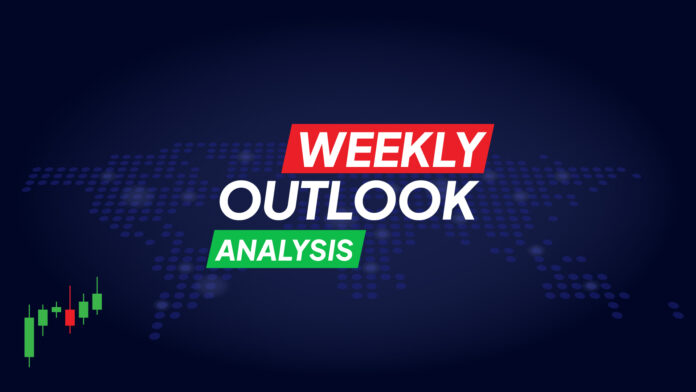The week of June 23–27 could prove pivotal for global markets, as investors navigate a mix of economic uncertainty and rising geopolitical tensions. In the U.S., attention will center on core PCE and consumer spending data, alongside Fed Chair Powell’s testimony—all under the shadow of tariff impacts and slowing consumption. Europe awaits June PMIs and Germany’s Ifo index for clues on economic resilience, while sterling faces headwinds despite strong PMIs and trade momentum. Inflation reports from Canada, Australia, and Japan will also guide rate expectations, as markets remain cautious amid the escalating Israel–Iran conflict and its implications for oil, currencies, and global risk sentiment.
For additional insights into market movements, explore our educational hub at https://hub.onequity.com, where you can access updated financial data, analysis, and trading resources.
Key Points To Watch Out For:
- Tensions between Israel and Iran will keep risk appetite in check.
- Data on core PCE and consumption in the U.S. may bring some much-needed relief.
- CPI data will be published in Canada, Australia, and Japan.
- Preliminary PMIs for June will be in focus amid tariff uncertainty.
Markets Watching U.S. Data Amid Economic and Geopolitical Uncertainty
Recent U.S. economic data has painted a mixed picture. While inflationary pressures remain moderate despite the 10% tariff on most imports, and the labor market continues to show resilience, consumer spending appears to be weakening. This has raised concerns that structural cracks may be emerging beneath the surface of the job creation narrative.
Personal consumption slowed to 0.2% month-on-month in April but is expected to rebound to 0.3% in May. Income growth, meanwhile, is likely to have moderated from 0.8% to 0.4%. The Fed’s preferred inflation indicators—the PCE indices—are anticipated to show modest increases, with headline PCE projected at 2.25% year-on-year and core PCE at 2.58%, partially reflecting the impact of tariff-induced cost pressures.
Fed Outlook in Focus
Attention will also be on S&P Global’s preliminary PMIs for June, which may reveal whether trade tensions are beginning to weigh on business sentiment and activity. Key releases this week include pending home sales for May on Monday, consumer confidence data on Tuesday, new home sales figures on Wednesday, and the final revision of first-quarter GDP on Thursday.
In addition to economic indicators, investors will closely follow Fed Chair Jerome Powell’s semi-annual testimony before Congress on Tuesday and Wednesday. The market currently expects a 50 basis point rate cut before year-end, but any hawkish comments from Powell—or indications that tariffs are feeding inflation—could challenge that outlook, potentially lifting the dollar and weighing on equities.
Geopolitical Risks Intensify with the Conflict Between Israel and Iran
The intensifying conflict between Israel and Iran adds another layer of uncertainty. While financial markets outside of the energy sector have largely remained calm, speculation is growing that the U.S. could be drawn into the conflict. Reports have surfaced suggesting that strikes on Iranian nuclear facilities may be considered.
Such developments could lead to rising oil prices, renewed strength in the U.S. dollar, and increased demand for safe-haven assets like gold. Equities could come under pressure globally. However, progress in trade negotiations—such as potential agreements with India or Japan—may help counterbalance these geopolitical risks.
The Euro Falls, but Outlook Improves
The euro, which had recently gained on concerns over U.S. global leadership, has come under pressure amid renewed focus on Europe’s energy vulnerability—especially regarding natural gas—due to the Middle East conflict. However, with the European Central Bank nearing the end of its easing cycle and eurozone growth showing positive surprises, the euro’s recent weakness may be temporary.
Market sentiment could shift again if preliminary PMI data on Monday, June 24, shows resilience. Germany’s Ifo business climate index, scheduled for release on Tuesday, June 25, will provide additional insight into economic sentiment within the region.
Sterling Faces Geopolitical Headwinds
The British pound has been one of 2025’s top-performing currencies, supported by strong first-quarter data, recent trade deals with India and the U.S., and a review of the existing agreement with the European Union. However, rising geopolitical tensions and the U.K.’s twin fiscal and trade deficits make sterling vulnerable to investor retreat during periods of market stress.
Even if PMIs released Monday, June 24, indicate stronger economic performance, sterling’s gains may remain capped as investors favor the U.S. dollar for its safe-haven status.
Canada: Inflation in the Spotlight
Trade negotiations between the U.S. and Canada appear close to resolution, but no formal agreement has yet been reached. Canadian inflation remains elevated, with some core indicators exceeding 3.0%. Tuesday’s CPI report on June 25 will be closely watched. If price pressures persist, the likelihood of a July rate cut—currently estimated at just over 20%—could diminish, potentially supporting the Canadian dollar.
Monthly GDP data for Canada, due on Friday, June 27, will also help shape expectations around the Bank of Canada’s policy trajectory.
Conclusion: Australia & Japan Inflation Outlook
Australia’s CPI release on Wednesday, June 25, could determine whether the Reserve Bank of Australia proceeds with a rate cut in July. Currently, markets price the likelihood of such a move at 65%. A stronger-than-expected inflation print could reduce the probability of further easing, providing a lift to the Australian dollar.
In Japan, inflation data will also take center stage. Tokyo’s core inflation rate hit 3.6% year-on-year in May, the highest in more than two years. If June’s figures also reflect accelerating inflation, expectations for another rate hike by the Bank of Japan could strengthen. That would likely support the yen, which has recently underperformed against the dollar amid global tensions.
Japanese preliminary PMIs on Monday, June 24, and a set of key figures—CPI, unemployment, and retail sales—scheduled for release on Friday, June 27, will be crucial in shaping the market’s view on Japan’s next policy moves.
Trade with confidence—get the latest market insights at OnEquity.com.



